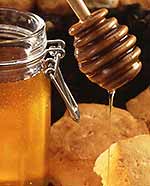
Manuka honey inhibits bacterial infections in multiple ways. Photo credit: USDA Scott Bauer
Manuka honey is one of my favorite home remedies for Staph and MRSA skin infections. Manuka honey is safe, inexpensive, easy to use and it can provide support against Staph and MRSA biofilms. And unlike essential oils and herbal products, it’s pretty easy to find high-quality Manuka honey products with the strength needed for stubborn infections.
One of the easiest and most helpful ways to use Manuka honey is on skin infections, especially open sores and wounds. Because it is so mild, it can be used repeatedly multiple times per day, applied directly to wounds. Most people tolerate honey quite well and reactions are rare.
A common way to use Manuka honey for a skin infection is to place it underneath wound dressings. Most people can replace their dressing 3 times per day with a fresh dose of honey applied each time. A dressing is simply a sterile bandage to cover the wound. Dressings come in various sizes and shapes and some have self adhesives while and others require tape to hold in place.
Staph and MRSA wound method
Below is a good method for using honey on wounds with dressings. The idea is to maximize contact between the wound and the honey by reducing the air-space in the gauze:
- Clean the wound with hydrogen peroxide or as directed by your physician.
- Pre-soak a sterile gauze pad with manuka honey.
- Drizzle honey into the wound and cover with a pre-soaked gauze pad.
- Cover the pre-soaked gauze pad with a waterproof dressing to reduce oozing of the honey onto clothing or furniture.
- Secure the dressing to the skin using non-irritating adhesive or tape.
- Take care to avoid irritating the skin to much if you have frequent dressing changes.
Manuka honey quality
As mentioned above, it’s pretty easy to find a good Manuka honey by following a few simple guidelines. Raw is generally best, except for babies, MRSA in children, and immune-compromised people. A potency of UMF 10 to UMF 15 is best for skin infections. Be sure to never use processed, regular store honey – only high-quality UMF rated honey should be used for a honey wound dressing or MRSA wound care.
The above method is easy to use and many people have excellent results with it. As with any remedy for the skin, you’ll get better results if you also get internal support for your infection, boost your immune system, and counteract the effects of any antibiotics you’ve taken (my guidebook covers these important steps in detail).
Also, because every wound and infection is different, be sure to talk with your doctor for the best type and size of bandage or dressing to use and how often to replace it. And if you have concerns, ask your doctor about any special precautions or steps to take for MRSA Manuka honey treatment.

- What’s the best natural remedy for controlling Staph or MRSA?
- How to use essential oils for cleaning and keeping bacterial out of your house.
- What are the pros and cons of alternative versus conventional treatments?
To your best health,
Michelle
Microbiologist and Natural Health Expert




